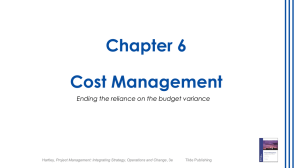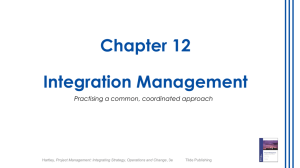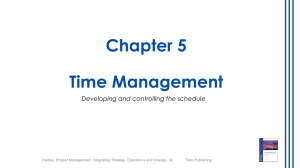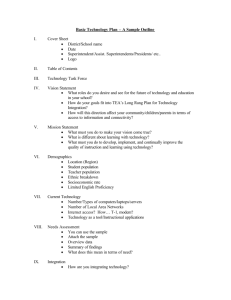Tb-Hartley-ProjectManagement3e-Ch10-PPTs
advertisement
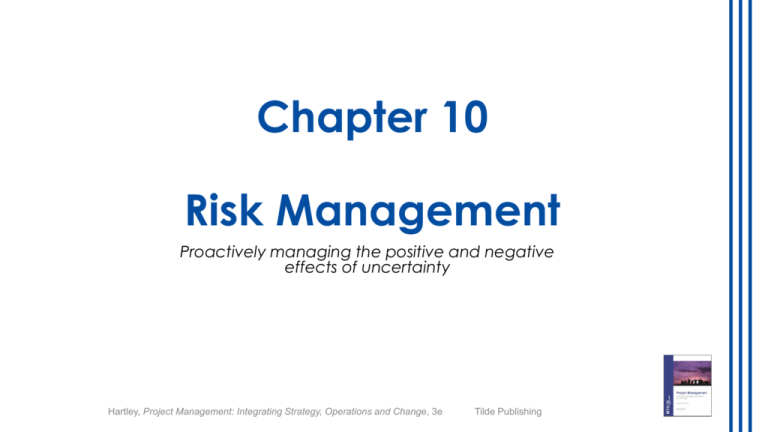
Chapter 10 Risk Management Proactively managing the positive and negative effects of uncertainty Hartley, Project Management: Integrating Strategy, Operations and Change, 3e Tilde Publishing Chapter overview 1. 2. 3. 4. 5. 6. Planning for risk management Identifying the risks Qualitative and quantitative analysis Planning risk responses Assigning accountability Controlling project risk © 2014 Hartley, Project Management: Integrating Strategy, Operations and Change, 3e Tilde Publishing 2 Planning for risk management Effect of uncertainty on (project) objectives Often a singular reliance on standard operating procedures Explicit, thorough and documented risk management planning activities will work towards not only evaluating and controlling project risks, but (and equally important) also delivering a successful project Begins with clearly understanding and agreeing exactly how the risk management activities for the project will be structured and performed © 2014 Hartley, Project Management: Integrating Strategy, Operations and Change, 3e Tilde Publishing 3 Identifying the risks Involves stakeholders (project manager, team members, clients, subject matter experts…) Anticipating and identifying risks that may affect the project May be internal or external Competition, political, environmental, social, financial, economic… The challenge is to identify the true source of the risk © 2014 Hartley, Project Management: Integrating Strategy, Operations and Change, 3e Tilde Publishing 4 Qualitative and quantitative analysis Reduce the level of uncertainty and/or impact and enable everyone to focus on the high-priority risks o the probability of the risk occurring • numeric value, descriptive label and explanation o the impact of the risk occurring • numeric value, descriptive label and explanation o the priority (or ranking) of the risk • probability x impact low: 1 to 6 treated by existing standard operating procedures medium: 8 to 12 require direct intervention by the project manager high: 16 to 25 require immediate escalation and intervention by senior management © 2014 Hartley, Project Management: Integrating Strategy, Operations and Change, 3e Tilde Publishing 5 Planning risk responses Acceptance: passive/active acceptance and the impact it may have on the project’s outcome Mitigation: taking specific action to reduce either the probability and/or impact of the risk event. Avoid: eliminating the threat to protect the project from the impact altogether. Transfer: relocate the impact of the threat, together with the ownership of the response, to a third party. Exploit: ensure that the identified opportunity is realised by eliminating the uncertainty around it altogether so that the opportunity definitely happens Enhance: actively increase the probability and/or positive impacts of an opportunity Share: split between partnerships, consortiums and/or mergers, where each party is contracted for their particular expertise © 2014 Hartley, Project Management: Integrating Strategy, Operations and Change, 3e Tilde Publishing 6 Assigning accountability Clearly, risk response strategies have to be assigned to the most appropriate stakeholder available to carryout out the required response If no one is assigned responsibility, there is a very high chance that no one will take any interest in the risk or its treatment As a shared responsibility, everyone on the project takes an active role in not only identifying and analysing risk but also in ensuring that capable resources are actually assigned to action and monitor the response strategy © 2014 Hartley, Project Management: Integrating Strategy, Operations and Change, 3e Tilde Publishing 7 Controlling project risk Identifying, assessing, analysing and responding to tentative risks at the start of the project does not mean that you are free from also constantly reviewing and controlling your risk assessment processes throughout the project Risk is not a static concept Ongoing control is what is needed to ensure that the challenges in managing risk are not squandered and that the many lessons presented throughout the project are, in fact, learned. © 2014 Hartley, Project Management: Integrating Strategy, Operations and Change, 3e Tilde Publishing 8 Review questions 1. Why is risk management crucial to project planning and delivery? 2. Summarise the steps in managing project risk and identify the role each plays in proactive risk management. 3. Explain the application of the probability and impact matrix and the benefits it delivers. 4. What are the common risk response strategies for both threats and opportunities throughout the project? 5. What are the individual actions required to be performed under risk control? © 2014 Hartley, Project Management: Integrating Strategy, Operations and Change, 3e Tilde Publishing 9 Group learning activities Discuss why risk management can be a difficult process to implement Brainstorm potential sources of risk for a project Debate whether both probability and impact can be treated through response strategies, or only impact Discuss the notion that all risk should not be treated equally Workshop examples of both positive and negative risk Discuss why risk management should be a shared ownership Discuss the differences between risks and issues © 2014 Hartley, Project Management: Integrating Strategy, Operations and Change, 3e Tilde Publishing 10 Assessment options Create a risk management plan that conveys how the risk management activities will be structured and performed Critique and report on useful approaches, tools or techniques commonly used to identify risk Develop a probability and impact table that facilitates both quantitative and qualitative analysis Develop a risk register template that aligns to the risk management process Short answer questions Multiple choice questions © 2014 Hartley, Project Management: Integrating Strategy, Operations and Change, 3e Tilde Publishing 11
